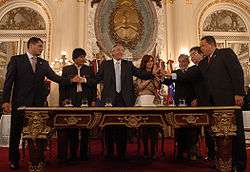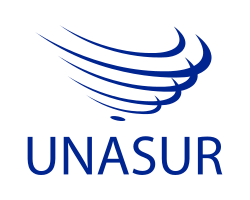Bank of the South
The Bank of the South (Spanish: Banco del Sur, Portuguese: Banco do Sul, Dutch: Bank van het Zuiden) or BancoSur is a monetary fund and lending organization established on 26 September 2009 by Argentina, Brazil, Paraguay, Uruguay, Ecuador, Bolivia and Venezuela with promises of initial capital of US$20 billion. Argentina, Venezuela, and Brazil were to have each pledged $4 billion, and Uruguay, Ecuador, Paraguay and Bolivia were to have contributed smaller amounts.[1][2] The intention of the bank was to lend money to nations in the Americas for the construction of social programs and infrastructure. Documents establishing the bank as an entity were signed in 2007, and the agreement between the countries was finalized in 2009, but as of 2016, the bank had not been capitalized.[3]
 | |
| Public | |
| Industry | Finance and Development |
| Founded | 2009 |
| Headquarters | Caracas |
Plans and involvement

The ultimate goal of the Bank of the South is to include every state within the region of South America. It has been established because of disapproval of the protocol of the World Bank and International Monetary Fund (IMF), in particular the enforcement of unrelated free market reforms on countries seeking emergency loans.[4] It also represents an attempt to achieve regional independence and endogenous development. The program would lend money to any nation involved in the construction of approved programs, and without conditions traditionally attached to such loans, such as deregulation.
The Bank is intended as an alternative to borrowing from the IMF and the World Bank. Hugo Chávez promised to withdraw from the IMF and encouraged other member states to do so as well. Latin America's dependence on the IMF fell dramatically between 2005 and 2008, with outstanding loans falling from 80% of the IMF's $81bn loan portfolio, to 1% of the IMF's $17bn of outstanding loans.[4][5] Brazil and Argentina are also refusing to borrow from the IMF again.
It is proposed that all member countries contribute fairly equal shares to the Bank's initial capital of fourteen billion Brazilian reais (seven billion US dollars) so that no member state will control a dominant share. Argentina joined with Venezuela to officially propose such an initiative, but Brazil also became a major player.[6] Additionally, the bank will feature a one-state one-vote structure, unlike the IMF.[7]
History
Founding
The concept was first raised during the first presidential campaign of Venezuelan President Hugo Chávez, in 1998.[5] Chavez consulted regularly with Mark Weisbrot,[8] who has been described as the "intellectual architect" of the project.[9][10][11] The concept was originally launched in 2006 in a cooperation between Venezuela and Argentina, led by their respective Presidents Hugo Chávez and Néstor Kirchner.[12] In April 2007, Brazil agreed to join.[13]
In May 2007, a meeting in Quito led to the official creation of the bank, and was said to indisputably signify another step towards Latin American integration.[6]
Seven South American nations met in Rio de Janeiro on 8 October 2007, to plan the beginning of the Bank. It was announced that the Bank will be headquartered in Caracas, Venezuela, and would begin operations on 3 November 2007; this was later postponed to 5 December 2007,[14] and then to 9 December 2007.[15] Representatives from Argentina, Bolivia, Brazil, Ecuador, Paraguay, Uruguay and Venezuela were present at the meeting. All 12 South American countries will be eligible to borrow from the Bank. In a surprise move, Colombia formally requested membership in the bank on 13 October 2007. As of 25 April 2008, the bank was still awaiting its member nations to have their local legislatures approve their individual capital investments. Member voting rights were yet to be determined at that time.[16]
In March 2009 a number of Latin American nations agreed to contribute US$7 billion towards the bank's start-up capital. Venezuela, Argentina, and Brazil are to contribute $2 billion each, and Ecuador, Bolivia, Paraguay, and Uruguay agreed to contribute varying amounts to provide the remaining US$1 billion.[17]
On 26 September 2009, the presidents of Argentina, Brazil, Paraguay, Uruguay, Ecuador, Bolivia and Venezuela signed an agreement establishing the South Bank with an initial capital of US$20 billion. Leaders including Brazilian President Luiz Inácio Lula da Silva and Argentina's Cristina Fernández de Kirchner formally signed up to the pact and announced that the starting capital would be US$20 billion. It was unclear how much each country would contribute, but under the previous US$7 billion figure announced in May, Argentina, Venezuela and Brazil were to have each pledged US$2 billion, while Uruguay, Ecuador, Paraguay and Bolivia were to have invested smaller amounts.[1][2]
Delay
The Bank of the South never received its first deposits by 2016, with South American governments still holding discussions on how to fund the bank.[18] By 2017, the Bank of the South program was on hold.[19] President of Ecuador, Rafael Correa, stated in May 2017 that, "There is no good news for the Bank of the South. It is in papers but it has not been able to start working and I fear that it will not be able to be done in the short term".[19] Following the controversies surrounding the 2017 Constituent Assembly of Venezuela in August 2017, Chancellor of Uruguay Rodolfo Nin Novoa stated that Uruguay was evaluating its exit from the Bank of the South as well as TeleSUR due to Venezuela's influence in the groups.[20]
Reception
In 2010, Americas Quarterly wrote that "Banco del Sur will have a negative effect on the region’s development and credit worthiness and dearly cost its members", saying that supporters of the bank's independence from international markets only use "rhetoric arguments" to defend the initiative, summarizing the effort as "another example of the populist ambition and misguided policies that have taken hold again in the region".[21]
Nobel Prize-winning former World Bank economist Joseph Stiglitz supported the idea, stating, "One of the advantages of having a Bank of the South is that it would reflect the perspectives of those in the South.... It is a good thing to have competition in most markets, including the market for development lending".[22]
See also
- Union of South American Nations
- Bolivarian Alliance for the Americas
- SUCRE (currency of the ALBA)
- Mercosur
- Mercosur Parliament
- Pink tide
- TeleSUR
- South–South cooperation
References
- "South American leaders sign agreement creating South Bank". MercoPress. 27 September 2009. Retrieved 27 September 2009.
- "Venezuela summit criticises West". BBC News. 27 September 2009. Archived from the original on 29 September 2009. Retrieved 27 September 2009.
- Mares, David R. and Harold A. Trinkunas (2016). Aspirational Power: Brazil on the Long Road to Global Influence. Brookings Institution Press.
Chavez made claims about never again having to seek funds from the IMF and having to endure its conditionality programs. Chavez even announced that Venezuela would leave the IMF (it did not, but did refuse to allow it to carry out formal reviews of the Venezuelan economy). ... Although an initial document for the establishment of the bank was signed in December 2007, it took another two years to finalize the agreement creating it. Among the controversial points was the question of voting rights ... The Bank of the South project, however, remains paralyzed six years after its ratification ... as of this writing in February 2016, the Bank of the South is still not capitalized ...
- Klein, N. (2007) The Shock Doctrine. Penguin Books.
- McElhinny, Vince. "Bank of the South" (PDF). Global Exchange. Archived from the original (PDF) on 17 December 2010. Retrieved 25 February 2011.
- "BancoSur should be a bank to finance a socialist economy". Z Communications. 18 May 2007. Retrieved 25 February 2011.
- "O Banco do Sul tem futuro?". Jornal da UNICAMP (in Portuguese). 13 August 2012. Retrieved 1 January 2013.
- Pino, Soledad (September 2007). "El Modelo Americano no es Mejor que El Europeo" (PDF). La Cave (in Spanish). pp. 44–47.
... se le considera el artífice intelectual del Banco del Sur, un proyecto impulsado por el presidente venezolano ... Segun fuentes cercanas, el propio Chavez consulta con cierta frecuencia a Weisbrot, aunque no siempre seguiría sus consejos. (He is considered the intellectual architect of the Bank of the South, a project initiated by the Venezuelan president ... according to sources close to him, Chavez himself consults Weisbrot with some regularity, although he may not always follow his advice.)
- "Banco del Sur: su objetivo contrarrestar la presencia del BM y del FMI". Diariocrítico (in Spanish). Retrieved 15 March 2018.
Mark Weisbrot, artífice intelectual del Banco del Sur (Mark Weisbrot, intellectual architect of the Bank of the South)
- "El Banco del Sur será un arma financiera contra EEUU, según sus promotores". America Economica. 18 September 2007. Archived from the original on 22 November 2008. Retrieved 15 March 2018.
Mark Weisbrot, artífice intelectual de la propuesta del Banco del Sur (Mark Weisbrot, intellectual author of the proposal of the Bank of the South)
- Cristóbal Carle, Gregorio (4 November 2008). "El Banco del Sur: un arma de la Revolución Chavista | GEES" (in Spanish). Grupo de Estudios Estratégicos. Retrieved 15 March 2018.
sus promotores - Mark Weisbrot, artífice intelectual de la propuesta (its promoters - Mark Weisbrot, intellectual architect of the proposal)
- "South America launches rival to the IMF, World Bank". Tehran Times. 11 December 2007. Retrieved 25 February 2011.
- Carlson, Chris (16 April 2007). "Brazil To Join Bank of the South". Venezuelanalysis.com. Retrieved 25 February 2011.
- Menéndez Quintero, Marina (3 November 2007). "El Banco del Sur será realidad en diciembre". Juventud Rebelde. Retrieved 25 February 2011.
- "South America ready to launch two major regional projects". MercoPress. 4 December 2007. Retrieved 25 February 2011.
- "Still on the Drawing Board: the Banco del Sur a Half Year Later". Council on Hemispheric Affairs. 27 May 2008. Archived from the original on 13 February 2011. Retrieved 25 February 2011.
- "Bank of the South takes off with 7 billion USD initial capital". MercoPress. 9 May 2009. Retrieved 25 February 2011.
- "Ecuador anuncia reunión para reimpulsar el Banco del Sur". La Radio del Sur. 27 August 2016. Archived from the original on 20 August 2017. Retrieved 19 August 2017.
- "Rafael Correa: El Banco del Sur no ha podido despegar". El Universo (in Spanish). 5 May 2017. Retrieved 19 August 2017.
- "Uruguay evalúa retirarse de Telesur y del Banco del Sur". La Diaria. 16 August 2017. Retrieved 19 August 2017.
- Artana, Daniel (24 February 2010). "Why Banco del Sur Is a Bad Idea". Americas Quarterly. Retrieved 30 May 2018.
- Carroll, Rory (12 October 2007). "Nobel economist endorses Chávez regional bank plan". The Guardian. Retrieved 25 February 2011.
External links
- Hugo Chávez moves into banking. Economist, May 10, 2007
- Wolf v. Wolf. Economist, May 10, 2007
- Bank of the South: A review of what is at stake. May 2007
- NBC news, May 2007
